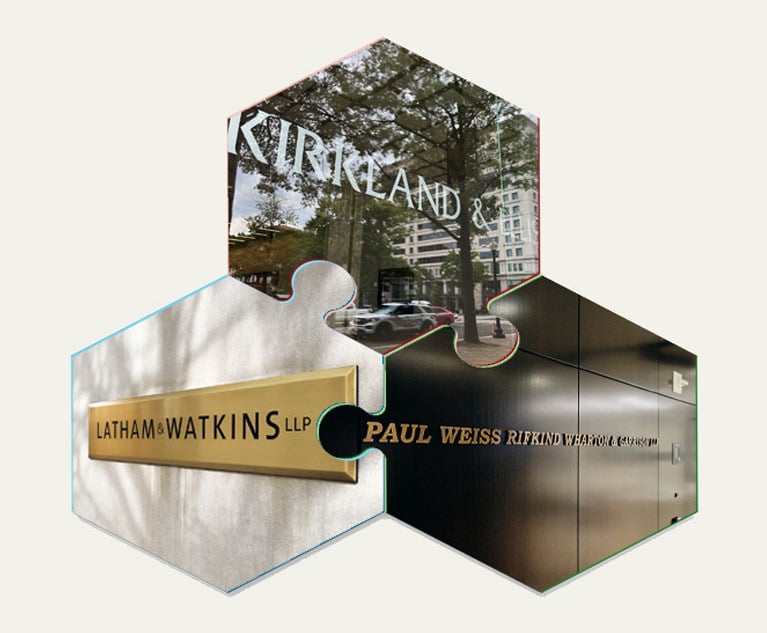The Legal Institute for Forward Thinking's Analysis of Today's Biggest Issues
The organization's mid-year discussion on trends in the legal market, included UnitedLex, the Big Four, differentiation, compensation, the repeal of Jewel v. Boxer and client lock-in.
August 23, 2018 at 05:00 PM
15 minute read

The Legal Institute for Forward Thinking recently convened for a mid-year discussion on trends in the legal market. Following are some of the primary points of the discussion. As always, meetings follow the Chatham House Rule, so accreditations will not be made.
UnitedLex and LeClairRyan's Engagement
First on our agenda was the discussion of the UnitedLex/LeClairRyan engagement; specifically, whether or not this would be the beginning of a large shift in the market. And in saving you the suspense, it doesn't seem likely.
Specifically, there are five boxes that need to be ticked for an engagement like this to be diffusion-friendly: (1) provide distinct advantage; (2) cultural compatibility; (3) relative simplicity; (4) trialability; and (5) observability. The advantage of something like this is quite relative; many firm cultures are not innately predisposed to such a dramatic shift; this type of commitment is very complex; it is very difficult to run on a trial basis; and lastly, it will be difficult for the market to “observe” the outcome of the relationship. In a vacuum, these factors will make it challenging for an engagement like this to really get steam behind its diffusion into the market. But moving outside of a vacuum and into the right environment, it may become fruitful. This bringing us to LeClairRyan:
LeClairRyan represents, for lack of a better term, the perfect storm of necessary attributes and criteria to make something like this adoptable, acceptable to the partnership, and otherwise effective—which, ultimately only time will tell.
Firm: As far as major law firms go, LeClairRyan is relatively young (established in 1988) and is unabashedly middle market—it knows, embraces, and plans its strategy around, this understanding. It also offers a full-service practice portfolio, is operationally focused, does its fair share of commodity-related legal work, and, while profitable in its own right, is lesser so than some of its larger peers.
Leadership: Further, hailing from the venture capital arena, the eponymous Gary LeClair is known for being exceptionally innovative and strategically minded and driven. The firm's culture has followed that disposition from its origins and is known for having a very thorough, well-articulated and ultimately well-executed strategy. And though LeClair left the firm's chairman role in 2015, he still carries significant weight and influence in the partnership's ranks.
Trust: Lastly, LeClairRyan had an existing relationship of trust in place with UnitedLex—they had opened a “legal solutions center” in 2013 with it.
The combination of the firm's attributes, stature and market-oriented pressures that arise from servicing the middle-market have created a very facilitative environment for the engagement of these two providers. Many firms are not in this boat. And for a firm to be receptive to this type of relationship, it will need to check off a number of the same boxes that LeClairRyan has: it will be in the NLJ 100 to 300 range, disciplined, unspecialized, operationally focused, harbor a culture that is either predisposed to change or is flexible enough to support change, etc. This is a relatively rare bird and combined with the challenges this type of relationship poses from a market diffusion standpoint, it is likely to be, at best, a slow bake.
Big Four Embedding Into In-House Legal Departments
What discussion about legal trends would be complete without touching on the Big Four? It would be difficult to deny that they are looking squarely at legal work for future cashflow. Audits are challenging, high commitment, high overhead, and even with really loyal clients, after five years or so, they move onto other providers. A corporation can't have the same auditor in perpetuity. So, are they a threat to Big Law? The answer is, it depends.
No one in the discussion was of the mind that there is no threat at all. Focused on operationally focused, commodifiable work that can be performed without offending Rule 5.4, the Big Four are currently taking away, and will continue to vie for more, legal work. However, there was some disagreement about how high they would be able to climb in the legal food chain.
The most profitable work is bet-the-farm; of course, the Big Four cannot lay claim to that work at the moment. But some participants are bullish on the consulting firms ultimately arriving at the big-boy's table, stating that either the rule will be willingly overturned by the American Bar Association—it has already received some serious consideration—or that there is the possibility of lobbying congress to forcibly overturn the rule. It is difficult to predict with certainty, but if either comes to fruition, it won't happen in the near-to-mid-term future. The bar is many-faceted, making it difficult to wrangle; and it protects (quite heavily) many important interests of a class that is influential in the rule's future. Where lobbying is concerned, it is expensive, challenging and truly a time-consuming endeavor.
It is quite reasonable to assume, however, that the Big Four are playing the long game
As of this moment, accounting firms are focused on more commoditized, legally oriented work in limited and specific areas. And while we don't see any attempts to handle any huge M&A deals, they are taking away material amounts of regional, lower-level work, in particular.
Considering the GE/PWC deal, it seems as though the plan may be to ultimately take more sizeable market share by way of embedding themselves within in-house legal departments. They are broadening and cementing relationships within the corporate legal departments by providing middle- and lower-level work, understanding the clients very thoroughly and only giving them what they need. In essence, they are playing nice for the moment. If you read between the lines of Deloitte's write-up on its legal consulting endeavor, we think you'll find that there is an end game that moves higher up the ladder.
Differentiation
So how does a firm combat the continued uptick in competition? Well, differentiate, of course. This concept ate up its fair share of the conversation and in the opinion of the group, remains one of the key challenges for law firms as they forge ahead.
Per the Altman Weil survey Law Firms in Transition (2018), 50 percent of law firms “do not believe that they project a distinct, compelling value that differentiates them from competitors.” This number was surprising to most of the group; we thought that it should be higher. Certainly, less than 50 percent of law firms are actually differentiated from their peers (at the firm level). A key follow-up question might be, “How, specifically, are you differentiated?” No doubt that is where things would get interesting.
Mind you, this is not to disparage law firms. While true differentiation is hard to accomplish in any setting, it can be force-multiplied in the legal market. To differentiate requires a focusing of efforts and resources into a certain practice and group of people. Going even deeper, this focusing will inherently move resources and capital from one area—i.e., group of people—to another. In layman's terms, it takes money out of one lawyer's pocket to put it into that of another. You can use the term “win-win” or “bigger pie” all you want, but on a shorter-term time continuum, law firm profits are, indeed, zero-sum.
Even the slightest understanding of human nature, and certainly any understanding of law firm economics, tells us that when you start to take money out of someone's pockets, they get uncomfortable. And if opportunities present themselves to those disenfranchised souls, departures occur.
Unless you happen to invent something like the client takeover (Skadden) or the poison pill (Wachtell) achieving true firm-level differentiation at this point in the history of Big Law is highly implausible. But, it is possible at more concrete and specific levels, such as geography or practice (in particular). Unfortunately, however, eight out of 10 firms currently lean on “client service” as their differentiating factor. But when pressed to define what “client service” actually means, they often struggle. And if everyone is providing good “client service” to get above the noise, they are only creating more noise.
While differentiation initiatives are certainly in the minds of (at least) leadership, the bulk of a firm's differentiation still sits at the hyperspecific level of rainmaker. Seven percent of all partners in the NLJ 350 are rainmakers, booking five to six times what everyone else does. They are ever-intimate with their clients' business; they study it; they key in on one or two insights that they know are relevant to their clients; they are branded; they are diligent; and most important, these partners provide 35 to 45 percent of billings at their firms.
In an industry that provides credence goods (the nature of legal services), it is very difficult for even the savviest consumers to effectively evaluate work product under normal circumstances and therefore evaluate the firms from which that product came. This makes these rainmakers the most visible, tangible version of reputational capital to the consumer, ultimately causing them to rely on those relationships when making purchasing decisions.
Compensation: Paying Rainmakers Appropriately
The above is likely not news to you. In many-to-most cases, these rainmakers are the firm's differentiation, rendering them more valuable than ever in this perpetually pressurized market. And in firms that aren't compensating competitively—particularly firms that sit very close to, or on, the lockstep polarity—they run the risk of losing their best people (see Cravath's loss of Scott Barshay, Eric Schiele, and Sandra Goldstein).
But at its highest abstraction, the prevailing legal culture can make it difficult for firm leadership to compensate those people effectively. There is equality baked into law firm cultures at the most fundamental levels. They are, after all, partnerships—or at least they are still called partnerships, the accuracy of the term varying on a spectrum—so their DNA has strands of beliefs and values that tend to (or at least want to) place their partners within economic earshot of each other.
But in this day and age, everyone isn't equal. And in some cases, they are dramatically unequal. And if firms don't find ways to effectively compensate their most important assets, they will take some gut punches. We are reminded of the warning in preflight: “Secure your own mask first before helping others.” Firms seeking differentiation need to ensure that their current platform of differentiation (their rainmakers) is secure, and then focus on group-level differentiation. If they don't, we will see more dramatic lateral acquisitions, and in some cases, more holes being poked in what were once bulletproof firm brands.
The Repeal of Jewel v. Boxer
Speaking of lateral movement, one of the most influential decisions in the lateral acquisition market has been that of Jewel V. Boxer, the “unfinished business” doctrine. The short version from the ABA's 38th National Conference on Professional Responsibility:
“Partnership cases or matters that are still pending at the time a partnership dissolves are the 'unfinished business' of the partnership, and thus are a partnership asset. Importantly, this reasons that because the UPA requires that former partners not be separately compensated for completing the firm's 'unfinished business,' any profits earned from those cases belong exclusively to the dissolving firm, even profits earned by former firm partners completing the cases or matters at their successor firms. Thus, the former partners, and their new firms, get nothing for the work they contributed to bringing the case or matter to a close. This rule has been applied to both contingent and hourly matters, and allows former partners who did no work on the matters post-dissolution to profit from the efforts of those who did, all at the expense of the successor firms.”
This rule has caused firms to take a really hard look at the state of the firms from which lateral partners are moving, lest they acquire a partner or partners from a firm that dissolves, opening them up to clawbacks. There have also been cases where wholly intact firms that lost laterals have gone after unfinished work that was carried over to the fleeing attorneys' new firm. Of course, these dynamics have caused firms to critically assess—as much as possible—the unfinished work of potential laterals, because no firm wants their newly minted partners working for their previous firm, for free. Nevertheless, there have been a number of due diligence errors in the last 15 years or so that have resulted in firms taking a real hit because of it.
Recently, however, the California Supreme Court has (very quietly) decided that “a dissolved law firm has no property interest in profits derived from work performed by its former partners, now employed by new firms, on hourly fee matters previously handled by the dissolved firm. In so ruling, the California Supreme Court confirmed that clients, not law firms, own legal matters.”
This decision overturns the previously held decision and now leaves very little, if any, responsibility at the feet of partners that are fleeing from a sinking ship and the firms that welcome them because if the firm ultimately goes bankrupt, there will be no clawbacks to fear. Further, it will be challenging for an intact firm to justify clawbacks on work that is performed at a new firm.
This may not sound like a bad thing—and in some cases it may not be—but it is easy to see where this will facilitate, in particular, the predatory poaching of partner-based assets from struggling firms that may otherwise have been able to court a merger partner. “Why buy the liabilities when we can just buy the assets?” Lastly, we can look for firms to embed in their partnership agreements increasingly punitive provisions applied to departing partners to help the firm defend against predatory raids on their partner talent.
Making Clients Sticky
The unsteadiness that arises from lateral movement (and therefore the loss of clients) is enough to upset the stomachs of even the most seaworthy leadership. And one antidote might be the institutionalization of clients—something much easier said than done. Along these lines, the group considered whether it might be possible to create an environment that could lock in client relationships. For example:
- Can we truly partner with this client and in so doing develop some agreed-upon service standards for how we will operate together to fulfill their needs?
- How can we position our technical expertise in such a way as to discourage clients from defecting?
- How do we become so easy to do business with, so comfortable a provider of legal services, that familiarity with our operating style breeds client retention?
- How do we become an inseparable part of the client's day-to-day business operation?
- How do we create a psychological connection with this client company such that we are perceived to be affiliated with something of enormous value?
- How can we create significant transfer costs associated with this client company ever moving their legal matters to some other firm?
- How do we provide the client company with an economic incentive to use our firm more often?
- How do we make ourselves the safer choice for this client company?
Feedback was clear: achieving most of these in a legal setting is a difficult task and are therefore unlikely to manifest in the market in a material way. The needs of clients are often incredibly dynamic and shift quickly, making it difficult to systematize and bottle products and services that tackle highly impactful problems that might cause a client to effectively lock itself into a firm.
The only effective on-the-ground solutions that have been observed (by the group) were (1) the carving out of contractually based alternative fee agreements—“we are going to do all of your work for five years at this rate”—and (2) formal client teams, with the latter seeming to work the best.
There are myriad advantages. A good client team does all of the diligence necessary to truly understand the client's industry and business, and the most important, the practical issues that affect both. The structure exposes the client to multiple disciplines and skill sets in a much more controlled and systematic way. The client knows that cross-border and cross-practice management is someone's formal responsibility at the firm; and perhaps of most importance is the resulting OTC factor: “I've got one throat to choke if something goes wrong.”
A fair number of firms have formal client teams, but there is no real structure and resources behind them. Some firms have client teams that arise organically, despite the lack of a formal structure. But to create a functional client team program that can effectively carry out its duties and be marketed to clients, there needs to be:
- a budget that can support the necessary activity;
- openly espoused and formally articulated support by management,
- articulated and assigned responsibility and accountability;
- some kind of activity-based methodology that will define the impact of losing that client; and
- a compensation model that rewards (or disciplines) in a material way based on the satisfaction, and continued patronage, of the client.
Anything short of this is generally a house of cards and can add more work without the desired payoff.
David J. Parnell is co-founder of the Legal Institute for Forward Thinking.
This content has been archived. It is available through our partners, LexisNexis® and Bloomberg Law.
To view this content, please continue to their sites.
Not a Lexis Subscriber?
Subscribe Now
Not a Bloomberg Law Subscriber?
Subscribe Now
NOT FOR REPRINT
© 2025 ALM Global, LLC, All Rights Reserved. Request academic re-use from www.copyright.com. All other uses, submit a request to [email protected]. For more information visit Asset & Logo Licensing.
You Might Like
View All

Change Is Coming With the New Trump Era. For Big Law, Change Is Already Here
6 minute read

Trending Stories
- 1Uber Files RICO Suit Against Plaintiff-Side Firms Alleging Fraudulent Injury Claims
- 2The Law Firm Disrupted: Scrutinizing the Elephant More Than the Mouse
- 3Inherent Diminished Value Damages Unavailable to 3rd-Party Claimants, Court Says
- 4Pa. Defense Firm Sued by Client Over Ex-Eagles Player's $43.5M Med Mal Win
- 5Losses Mount at Morris Manning, but Departing Ex-Chair Stays Bullish About His Old Firm's Future
Who Got The Work
J. Brugh Lower of Gibbons has entered an appearance for industrial equipment supplier Devco Corporation in a pending trademark infringement lawsuit. The suit, accusing the defendant of selling knock-off Graco products, was filed Dec. 18 in New Jersey District Court by Rivkin Radler on behalf of Graco Inc. and Graco Minnesota. The case, assigned to U.S. District Judge Zahid N. Quraishi, is 3:24-cv-11294, Graco Inc. et al v. Devco Corporation.
Who Got The Work
Rebecca Maller-Stein and Kent A. Yalowitz of Arnold & Porter Kaye Scholer have entered their appearances for Hanaco Venture Capital and its executives, Lior Prosor and David Frankel, in a pending securities lawsuit. The action, filed on Dec. 24 in New York Southern District Court by Zell, Aron & Co. on behalf of Goldeneye Advisors, accuses the defendants of negligently and fraudulently managing the plaintiff's $1 million investment. The case, assigned to U.S. District Judge Vernon S. Broderick, is 1:24-cv-09918, Goldeneye Advisors, LLC v. Hanaco Venture Capital, Ltd. et al.
Who Got The Work
Attorneys from A&O Shearman has stepped in as defense counsel for Toronto-Dominion Bank and other defendants in a pending securities class action. The suit, filed Dec. 11 in New York Southern District Court by Bleichmar Fonti & Auld, accuses the defendants of concealing the bank's 'pervasive' deficiencies in regards to its compliance with the Bank Secrecy Act and the quality of its anti-money laundering controls. The case, assigned to U.S. District Judge Arun Subramanian, is 1:24-cv-09445, Gonzalez v. The Toronto-Dominion Bank et al.
Who Got The Work
Crown Castle International, a Pennsylvania company providing shared communications infrastructure, has turned to Luke D. Wolf of Gordon Rees Scully Mansukhani to fend off a pending breach-of-contract lawsuit. The court action, filed Nov. 25 in Michigan Eastern District Court by Hooper Hathaway PC on behalf of The Town Residences LLC, accuses Crown Castle of failing to transfer approximately $30,000 in utility payments from T-Mobile in breach of a roof-top lease and assignment agreement. The case, assigned to U.S. District Judge Susan K. Declercq, is 2:24-cv-13131, The Town Residences LLC v. T-Mobile US, Inc. et al.
Who Got The Work
Wilfred P. Coronato and Daniel M. Schwartz of McCarter & English have stepped in as defense counsel to Electrolux Home Products Inc. in a pending product liability lawsuit. The court action, filed Nov. 26 in New York Eastern District Court by Poulos Lopiccolo PC and Nagel Rice LLP on behalf of David Stern, alleges that the defendant's refrigerators’ drawers and shelving repeatedly break and fall apart within months after purchase. The case, assigned to U.S. District Judge Joan M. Azrack, is 2:24-cv-08204, Stern v. Electrolux Home Products, Inc.
Featured Firms
Law Offices of Gary Martin Hays & Associates, P.C.
(470) 294-1674
Law Offices of Mark E. Salomone
(857) 444-6468
Smith & Hassler
(713) 739-1250










